"Cody needs a puppy" has been my sporadic mantra ever since Tater
died four summers ago.
A large yellow American field Lab, Tater was seven years old when we
got Cody, a black male English Lab, as a six-week-old pup in the spring
of 2003. Tater-Tot had been our sole dog for three years after her
companion, another black male English Lab named Bubba, had died.
Like all pups I've had, Cody latched onto Tater immediately, playing
as roughly with her as he probably had played with his littermates:
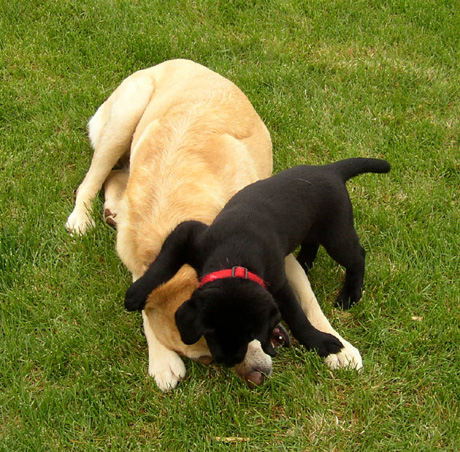
Tater and Cody, who was about 7
weeks old, playing in our yard in Billings, MT (5-16-03)
Occasionally she'd snap at him when he figuratively crossed some
boundary she established but in general she was loving and quickly
accepted the little miscreant. In fact, she became more puppy-like
herself!
It was fun watching them interact as Cody grew to his full size,
still smaller than Tater but more than able to fend for himself:
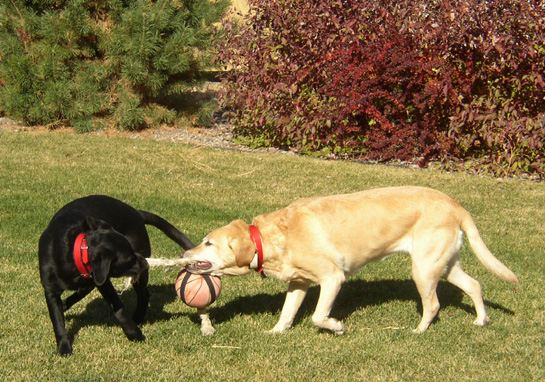
At 6½
months of age, Cody (L) was getting close to his full size.
(10-9-03)
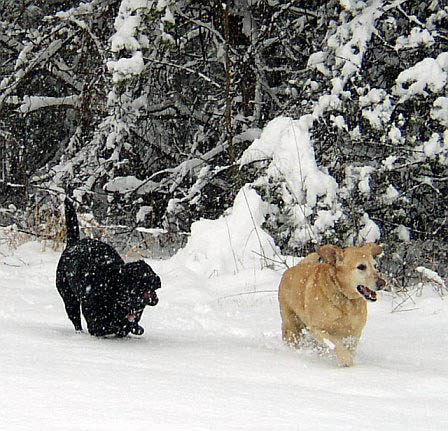
Cody and Tater look like they're laughing as they
run through the snow
at our house in VA. They were inseparable for over
five years. (2-28-05)
Now the cycle repeats itself.
We brought home an energetic little ball of fur three weeks
ago and now
Cody's getting payback for all the grief he caused Po' Tater as he was
growing up!
He's loving it, though. We're very pleased with how quickly he
accepted the new puppy and how much he loves playing with her.
For example, when she takes a breather to get water or inspect something
to sniff or chew, Cody grabs a toy, gets down on this front legs with
his butt in the air, wags his tail, and makes playful growling noises to
get her to come back for another round of wrestling and tug!
TIME FOR A PUPPY
We have been traveling in 5th-wheel campers an increasing amount of
time each year since we got Cody. Jim retired when Cody-pup was ten
months old. We had plenty of room for two 70-80 pound dogs that both
loved to ride in the truck, live in the camper, and share our adventures around the country:
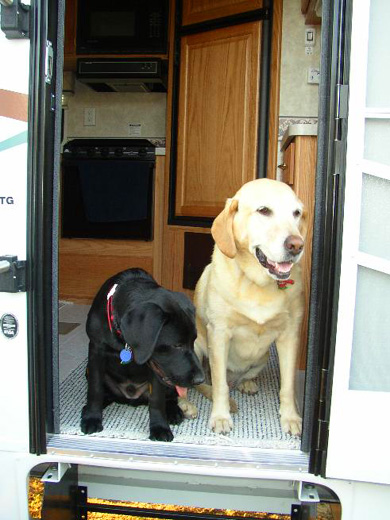
We're ready to go again!! Cody was about four
months old when I took this
picture of him and Tater in the doorway of our
HitchHiker 5th-wheel camper in 2003.
After Tater died we discovered that it was easier
to travel with just one dog.
Cody was 5½ years old then, still full of pup-like energy
but always a well-behaved
boy. He got lots of attention from us but I could tell from his reaction
to other dogs he met that he'd probably be happier to have a canine
companion 24/7 again.
I bugged Jim for a couple years about getting a puppy while Cody was
young enough to enjoy it. I didn't insist, however, because we were
traveling in our RV for three to five months at a time by then and
staying at our house for only four to six weeks in the spring and fall.
That kind of schedule wouldn't be practical for us or fair to a little
puppy that would need more consistency, training, and medical care the first four
or five months of its life.
This year was so busy that I'd pretty much forgotten about getting a
puppy anytime soon. I figured that wouldn't happen until Cody died. So
imagine my surprise when Jim said this fall might finally the right time!
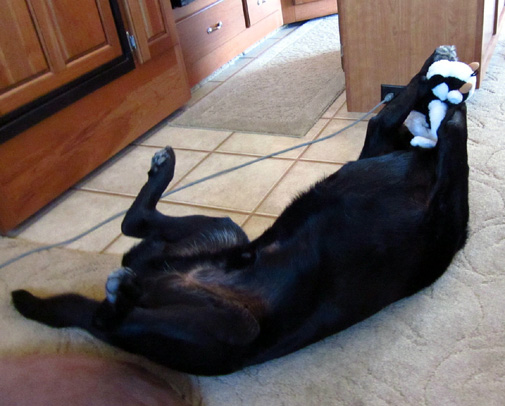
Cody still acts like a puppy at
age 9. I took this photo of him last winter while he played with a
long-
legged stuffed toy on the floor inside
our camper. Now he shares his toys with his new playmate.
On the long journey back to our Virginia house from Alaska in
September and October we both agreed that we're "tripped out" and need a
break from traveling for a few months.
Although our travel plans are still fluid we decided there are also
so many things that need to be done to our house and yard in preparation
for selling it that we probably won't get back on the road again until
after the first of the year.
Once we decided that we'll be at the house at least through December,
Jim was the first to realize that it would be a good time to get
a new pup.
I never expected him to be the one to initiate this discussion! He's
come a long way since I moved into his life with two big dogs thirteen
years ago, one of those "love me, love my dogs" arrangements.
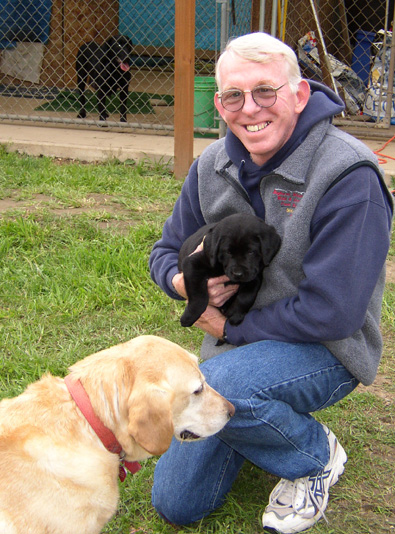
Jim holds 6-week-old Cody the day
we picked him up from the breeder
in Oregon; Tater doesn't look so
thrilled about the little guy! (May, 2003)
I've had dogs my whole life. They are my "fur kids." My
family had German shepherds on our farm when I was a kid. The
only time I haven't had dogs is when I was in college. It's
hard for me to imagine not having one or two dogs.
Jim's experience
with dogs was very different. He vaguely remembers a dog his parents
owned when he was a little kid but he never lived with any dogs of his
own until age 51 when I moved in with Tater and Bubba.
Since then Jim's come a long way in terms of enjoying living with one
or two dogs.
Cody had a lot to do with that. When we got him 9½
years ago Jim was still working. I had already retired so I was the
primary puppy trainer. After Jim retired and Tater died, he spent an
increasing amount of time with Cody. He has morphed into a genuine dog lover, a man who can
happily cuddle a soft, wiggly little puppy in his lap (if she'll sit
still) and romp on the floor to play with her and Cody:
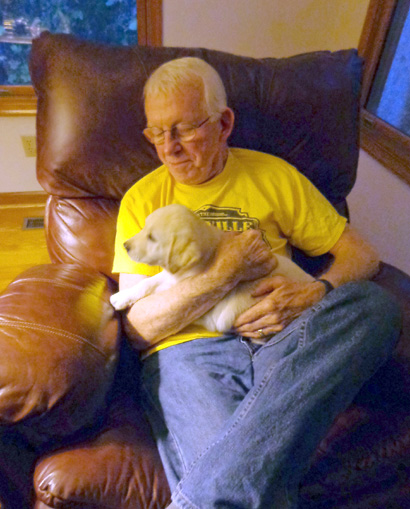
Our new little bundle of fur and
teeth (10-13-12, eight weeks old)
I love it. Jim's even good about taking our new puppy outside to pee
and poop.
Repeatedly, I might add. Little pups have little bladders and not a
lot of sphincter control.
MEET CASEY
That's the little pooper's new name, not the fancy one for her AKC
registration but the one everyone will know her by.
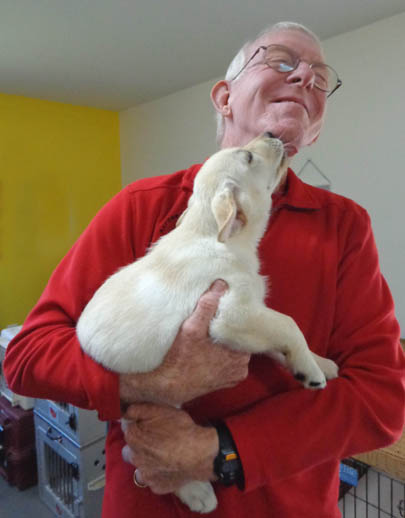
Puppy love! Jim and I both
got enthusiastic kisses from Casey as soon as we
each held her in our arms at the
breeders' farm on the day we picked her up.
That is one well-socialized puppy! (10-12-12,
eight weeks old)
It was Jim's turn to Name the Pup. Unless you get an older dog that
already has a name, choosing a suitable name for a young puppy is one of your first tasks.
Sometimes I've already picked out a name for a pup before I've even
seen it. That happened with Cody. Other times I've waited a couple days
to learn more about the pup's personality before choosing its name. This
time Jim asked me to come up with some female dog names that I liked and
then he'd pick his favorite after we met her.
We agreed on the generalities -- don't repeat any names of the
dozen dogs I've
previously had, the names of people we know, or the names of people's
dogs we know. We also knew we wanted two syllables and a name ending
in "y" or "ie." That kind of name easily rolls off the tongue when
you're calling a dog or giving commands.
That still left numerous possibilities.
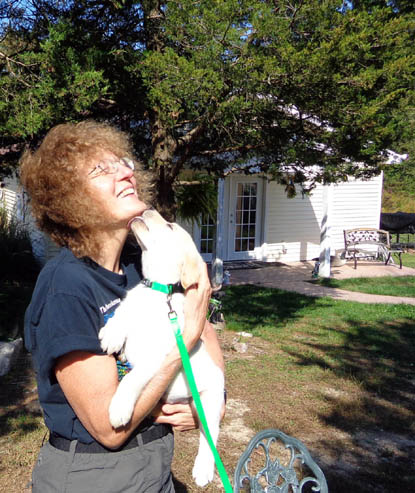
"Money will buy you a fine dog, but only love can
make it wag its tail."
(a Richard Friedman quote) The same applies
to puppy kisses.
For some reason it was easier for me to come up with male Lab names
than female ones. Some I thought of were appropriate for either gender,
like Bailey and Riley. I also found a couple suitable names several
generations back in Casey's pedigree but hadn't hit on just the right
ones yet.
I looked online for suggestions and found
hundreds. Yikes! There are even more names for dogs than humans. When I put
"female dog names" into the search box, Google
listed several more detailed search options like "female dog names for
Labs" (not surprising, since that's the most popular breed of
dog in the U.S.) and "female dog names that end in ie or y."
How handy! You really can find anything you're looking for on
the internet.
We didn't know for certain when we'd be picking up our new pup until the
afternoon before we got her. Jim had already whittled my initial list of
about twenty names down to six or seven but he hadn't chosen one yet. On the long drive to the
breeders' farm the next morning we went over our abbreviated list of names and
thought of Jessie and Casey, two more names good for
either males or females.
We added those to Nikki, Morgan, Amber, Holly,
and Cameo (Kami) but still didn't settle on Casey until later that night after
we returned home with our little girl. It just seemed to fit what we
were already learning about her personality.
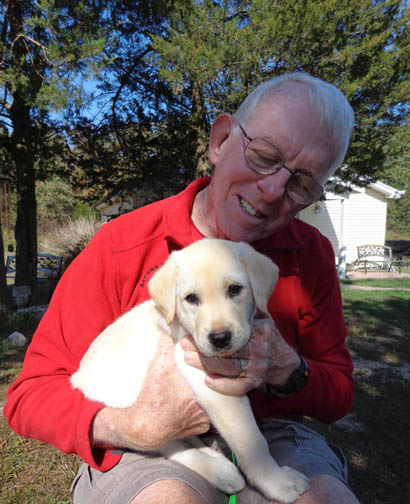
Another cute Casey photo from the
breeders' farm. She was 8 weeks,
2 days old when we got her. She weighed
13+ pounds. (10-12-12)
What Jim didn't know was that Casey was also my first or second choice. I told
him after he picked it.
"Casey" comes from an Irish Gaelic word meaning brave, vigilant, and
watchful. By nine weeks of age she was already quite brave and
adventuresome. We expect she'll be as good of a watchdog as my four
previous Labs, too. (Ha! Labs let you know someone is outside because
they want to play with them!)
Jim is part Irish (O'Neil is his surname)
so Casey's name is even more meaningful to us.
Casey and Cody. We like the sound of that. By now both dogs know each
other's name, although independent little Casey sometimes ignores hers
when she's too busy investigating something to come to us. We're working
on that . . .
CHOOSING OUR PUPPY
More important than choosing a name for our new pup -- or even
trying to find a source for one -- was first determining the characteristics we
wanted in a new dog. We had several important criteria.
1) We knew that we wanted another Labrador retriever because I've had
four of them already and think they are the ideal size and temperament
for us. There are some very good reasons why Labs are the #1 breed in popularity
in the United States.
2) We decided that a female would be preferable for two reasons --
responsibly-bred female Labs tend to run smaller than males, and we
thought a female would be more compatible with Cody. He's neutered but
we didn't want to risk turf wars with another male dog in the household.
We didn't totally rule out getting another male, though.
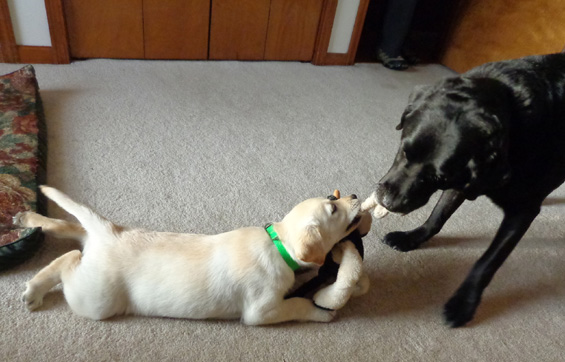
This isn't a turf war, it's a friendly game of tug with a
long-limbed stuffed cow.
(10-18-12, age 9 weeks)
3) A yellow pup would be nice so we can more easily determine which dog is
which from a distance. Cody is black. (We aren't as fond of chocolate
Labs, the third color.) Color was our least important consideration, however.
4) We determined that an all-English Lab would be more likely to have the
type of calm temperament we want at this stage of our lives when we
can't run any more and don't have as much energy as we used to have.
All-English Labs tend to be less hyper and need less exercise than
all-American Labs, but not always. It can take an American Lab pup two
or three years to become more calm.
There are two types of Labrador retrievers -- the stockier
English build that is the standard for the breed in regards to
conformation (body type), and the thinner American field version that is
used more frequently for hunting and trials. The two types can be bred type-to-type
or between types, depending on what characteristics the breeder is looking
for in the pups (assuming the breeder is responsible enough to consider temperament
and aptitude).
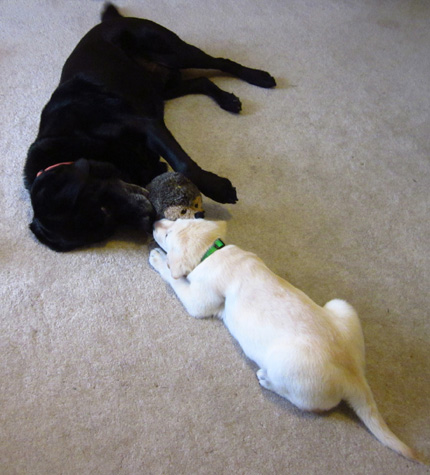
Casey has the classic blocky
head and "otter" tail that defines the
build of an all-English Lab.
Cody has some of the traits of both Lab types.
I've now owned all three variations of Labs.
Callie and Tater were
high-energy, all-American field Labs -- sweet personalities but more challenging to
train, independent and adventuresome, always needing a lot of exercise.
Bubba was all-English, the most laid-back dog I've ever had once he
reached maturity at about two years of age. Cody is half American (dam),
half English (sire). His build is compact, mostly English-looking but on the
small end of the weight range for a male Lab (his sire was BIG). His
muscular body is trim and fit, more like his mother's (she was small).
Of these four Labrador retrievers Cody is by far the most
responsibly-bred one I've had, with the best personality and
temperament, the most intelligence, and the best health. If we'd had our
druthers, we would have just cloned Cody instead of hunting for another
dog!! We think he's perfect (except for his drooling, Jim says).
5) Using Cody's good health and looks as an example, we also knew we wanted
another well-bred puppy whose parents have excellent OFA (hips and
elbows) and CERF
(eye) testing results to reduce the chance of future health problems.
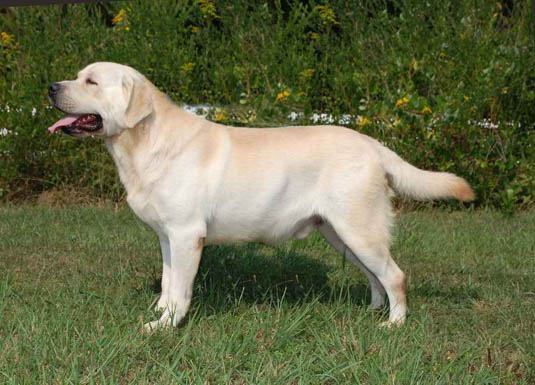
This is Casey-pup's sire, a big
handsome four-year-old champion with hips, elbows, and eyes certified as
"excellent." (Breeder's photo) I'll include another photo
I took of Siskel when we picked up Casey.
Like several other large breeds of dogs, Labs often develop joint
problems such as hip dysplasia and arthritis.
Research indicates that almost half of
the time this is due to genetic factors from indiscriminant,
unintentional, or improper
breeding. The remainder is up to the breeder in the first few weeks of
the puppy's life and to the new owner, especially during the dog's first two
years (i.e., proper nutrition, low to average weight, and other care).
My first three Labs were AKC registered but came from back-yard
breeders in the Atlanta area. All developed various medical issues that
were expensive to treat over the course of their lives and they all died
earlier than they should have.
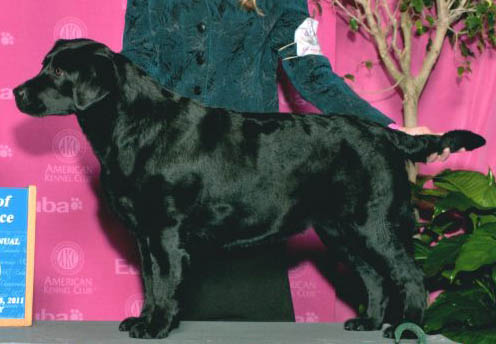
Casey's dam (Easy) also has excellent
hips, elbows, and eyes. What a gorgeous dog!
She was the #1 female show Lab in the USA in 2011.
(Breeder's photo)
We paid two or three times as much for Cody initially as any of the
three backyard-bred Labs I had but he's been
much less expensive throughout his life because he hasn't had any major
or chronic health problems. Although he has more and more gray hairs
he's still fit to hike all day, play hard with Casey, and act with
pup-like silliness when he wants to play -- and he's pushing ten
years of age.
His health and playfulness should be obvious in the photos I'll show you
in this series of entries where he's playing with Casey. Neither one wears out very
fast!
OK, WHERE DO WE FIND ANOTHER DOG AS PERFECT AS
CODY??
While we were still out on the road in the last few weeks of our
Alaska trip I began a diligent search for a new pup on the East coast. I
figured I'd better get on it before Jim changed his mind!
We got Cody from a hobby** breeder in Oregon when we lived in Montana.
That wasn't practical this time, since we're back on the East Coast for
a little while, so we didn't contact him.
[** I don't know anything about the person who wrote this
comparison of hobby vs. back-yard dog breeders but it's an
excellent list. So is the commentary at the bottom of that page.
The breeders from whom we got Casey are professional dog
breeders/trainers, another step higher than hobby breeders.]
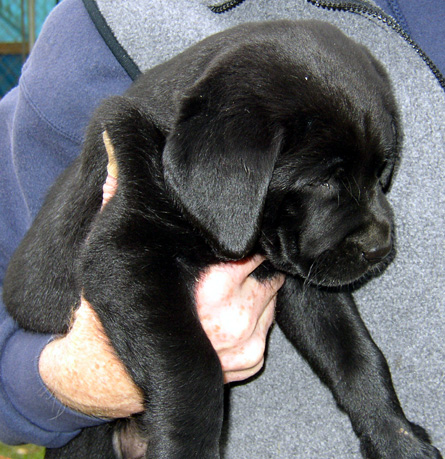
We first met Cody, his litter,
and his dam when the pups were five weeks old. We had to wait
another week to take him
home. Six weeks was really too young to leave his litter but he
did well
in our home. Note the thick,
shiny, velvety black hair, a hallmark of a well-bred Lab. (May,
2003)
In the search that eventually led us to Casey, my first call was to
our veterinarian in the Roanoke area. He used to breed Labs but no
longer does. A good hobby breeder, he carefully considered genetics and
temperament when breeding his dogs.
He referred me to a local family whose female Lab he matched to one
of his "grandsons," as he jokingly called the sperm donor (he owns the sire of the sire of this litter). I
contacted the family and learned that the litter wouldn't be born until the
third week of October, which would mean not getting the puppy until mid-
or late
December.
We let them know we were interested but would continue to look for a
puppy that was available sooner.
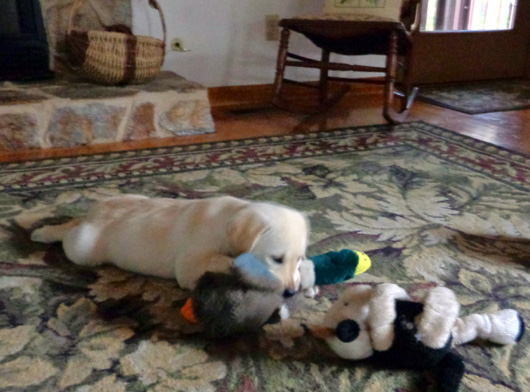
"This is one of the ducks (and a
cow) I get to
play with. My new family won't be hunting real ducks
with me. That's OK. They
have lots of other plans for fun things I can do." (Casey, 10-14-12, age 8
weeks)
That was anther one of our criteria -- getting a pup soon
after we got back to Virginia, if possible, so we could do basic and
potty training before really wintry weather sets in. We knew we were in
for a lot of trips outside each day.
We also knew we'd
have to stay at our house and not go on another distant RV trip until the pup was several months old, had all
her shots, was completely potty trained, and had learned some manners.
We searched purebred Lab rescue organizations but didn't come up with a
puppy that suited our needs or was reasonably close enough to our area.
We did not consider a shelter dog this time, for the health and
temperament reasons cited earlier. I've had a couple rescue dogs
before (one was part Lab) and inherited too many problems with them. Most puppies and dogs
in shelters are placed there because of careless breeding and/or
behavior problems. I know adopting a dog from a shelter is
considered a noble thing to do and often works out well for the new
owners but at this point in our lives we didn't want to take that much
risk.
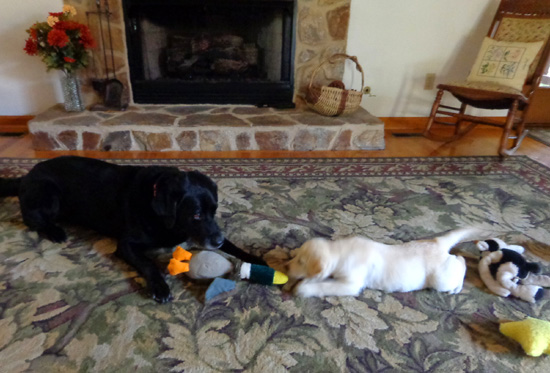
"Cody
sure is nice to share his toys with me. I think I'll sneak up on
this duck and try to
get it away from him. Uh, oh. He's knows I'm coming."
(Casey, 10-14-12, age 8 weeks)
We did not check any sources for a pup from a backyard
breeder -- for the same reasons we didn't choose a shelter dog.
Our goal became finding the best-bred puppy we could afford.
A diligent web search eventually led us to the
breeder where we got
Casey, a long-established business run by a well-respected veterinarian and her husband who breed,
raise, and train champion Labrador retrievers for show, hunting,
breeding, service work, and/or great family pets. Their business is
considered to be one of the top training, breeding, and canine
health-care facilities in the country. They also run a boarding facility
for any breed of dog.
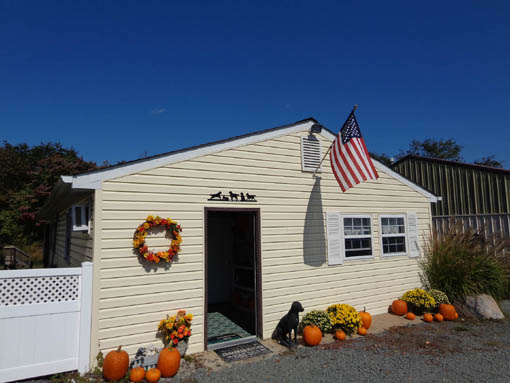
The entrance to the boarding area
is decorated for fall.
We were intrigued by the comprehensive information on their
website, their high breeding standards, the long line of champion show
dogs and hunters they've produced, the looks of their puppies, the
socialization and training they give their pups before releasing them to
new owners, and the expert qualifications of the couple who run the
place.
Not only is the breeder an experienced veterinarian, she also
has advanced training in animal behavior, canine reproduction, canine
sports medicine, and integrated canine medicine (homeopathy, herbal
medicine, chiropractic, and acupuncture). She has shown dogs in breed and field competition
for several decades.
Her husband is an expert in dog obedience and retriever field training.
Together they publish articles, host dog demonstrations, clinics, and
competitions, and contribute to TV programs, training videos, and
outdoor magazines.
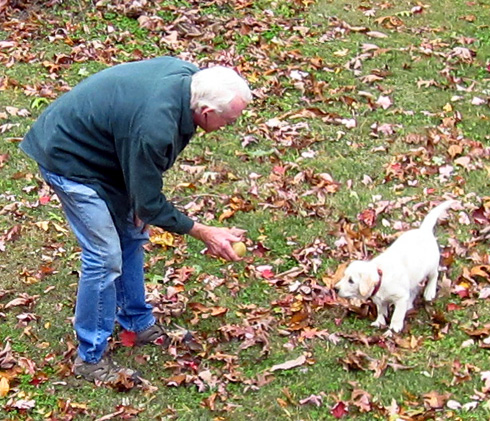
Casey began training to
retrieve objects at the breeder's farm before we got her.
Here Jim gets ready to
throw a tennis ball for her to chase. (11 weeks old)
Much of the information about credentials we found on other websites, not theirs.
Because we don't know anyone else who has purchased a puppy at
this place, and you can't always trust what you read or see on
the internet, we searched for both positive and negative
information about the breeder.
We found numerous positive
articles, references, and proof of the numerous titles that their
adult dogs have won but nothing negative
about the quality or care of their puppies or dogs.
The worst we found was anti-breeder sentiment from well-meaning
but uninformed advocates of
rescued/shelter dogs who don't understand the importance of maintaining
high breed standards (of every breed, not just Labs).
Use your common sense, folks. If no one breeds high-quality
dogs, they'll all eventually be mutts and you won't have any idea what
you're getting when you purchase/adopt one.
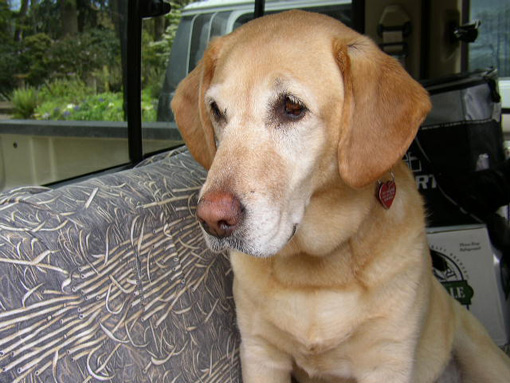
Tater was the product of a
backyard breeder (from the family of a Boy Scout trying to earn a
merit badge). She
was a lovable, spirited dog but she had some medical problems, she didn't
conform well to breed
standards for her body build/structure, and she was totally hyper.
If you buy a well-bred
Labrador retriever you pretty well know what you're getting in terms of
its size, looks, health, and temperament.
For example, this is what the AKC
standard says about the breed's temperament, i.e., what judges are
looking for in dog shows and what responsible breeders always consider
before mating two dogs:
True Labrador retriever temperament is as much a hallmark of the
breed as the "otter" tail. The ideal disposition is one of a kindly,
outgoing, tractable nature: eager to please and non-aggressive towards
man or animal. The Labrador has much that appeals to people: his gentle
ways, intelligence, and adaptability make him an ideal dog.
Aggressiveness towards humans or other animals, or any evidence of
shyness in an adult, should be severely penalized. [in dog shows]
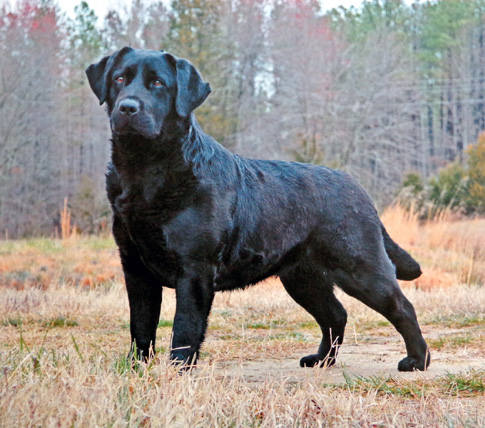
This is another picture of Casey's dam, who
exemplifies the conformation standard of the
breed. Ironically, Cody looks more like her than
Casey will, since Casey is a yellow Lab.
(This dog's coat is pure black, not bluish.
I took a photo of the photo the breeder gave us.)
Most of the pups from Casey's breeder are sold to folks who want to hunt,
show, and/or breed championship Labrador retrievers.
Pups they either can't
sell at the high prices such pedigrees can command, or pups that
the breeder deems aren't perfect enough in some way to become show
champions or exemplary breeding stock, are allowed to go to
folks like us who just want
healthy, handsome Labs with good temperaments and high
intelligence. They can also become great duck hunters, agility
competitors, rescue dogs,
assistance dogs, and/or therapy dogs with proper training.
We don't want to hunt, breed, or show Casey, although the
breeder says she'd be suitable for any of those things.
We might train her for pet therapy like I did with three of my other Labs
and/or agility training just for fun.
Since we will get Casey spayed we received a limited AKC
registration and paid considerably less for her than if we wanted a full
registration for showing and breeding purposes. She was still
expensive enough that Jim jokes that he paid less for his first car
than for Casey!
I countered that a used 1958 Chevy Bel Air didn't cost much in 1964
(classics like that are worth plenty now if they are in good
condition, however).
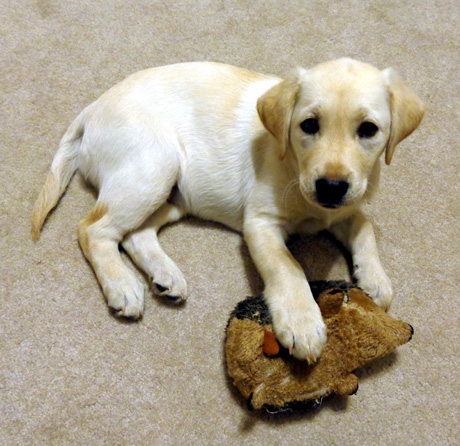
What big eyes you have, Casey Girl!
Who can resist that face? (10-30-12, almost 11 weeks old)
I have pictures of Cody and Tater playing
with these hedgehog toys when they were both
pups (1996, 2003). PetSmart still sells 'em.
I love the way the toys grunt, not squeak.
Casey comes with a full joint and eye guarantee, as do all puppies
from this breeder. Unless our vet suspects a problem later on, we probably won't do the OFA and CERF testing
that is required to activate her guarantee between one and two years of age to determine
if she has any congenital hip, elbow, or eye defects.
We did those tests for Cody between one and two years of age. We
didn't buy him with the intention of breeding him but as he grew
we considered it because of his intelligence, good looks,
and ideal temperament. His eyes and elbows were fine but he
tested
between "good" and "fair" for hips. We would have been
irresponsible to use him for stud, even though he looked fine to
us and still has no signs of hip problems at age 9½
years -- despite all
the running he's done. We ended up getting a partial refund on
the price we paid for him (it paid for the testing) and we had
him neutered.
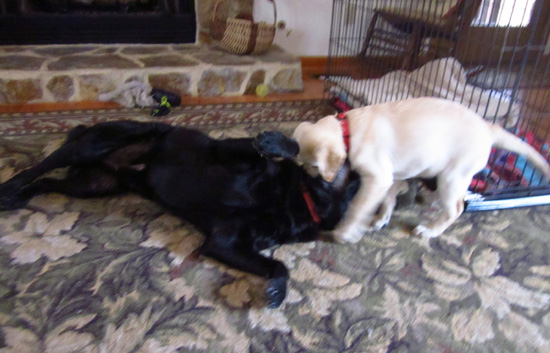
It won't take long before Casey is about as
big as Cody. (11-1-12, age 11 weeks)
Casey's breeder gives new owners considerable information not only
about the genetic testing the puppies' parents have received but also about
raising a healthy pup to adulthood -- training,
nutrition, socialization, etc.
The requirements of the
guarantee mandate what commercial foods Casey can eat and what
supplements she must get until she is two years of age (one is
for healthy joints, the other for her skin, coat, and digestive
system).
We've decided to give the supplements to Cody, too.
We will
follow the requirements of the guarantee because the breeder is totally credible
and well-respected; she has
considerable experience and knowledge about raising healthy Labs
without joint and other health problems.
Next page: watching Casey and her litter grow,
meeting our new puppy, and introducing her to Cody
Happy trails (and tails!),
Sue
"Runtrails & Company" - Sue Norwood, Jim O'Neil, Cody the
ultra Lab, and Casey-Pup
Previous
Next
© 2012 Sue Norwood and Jim O'Neil























